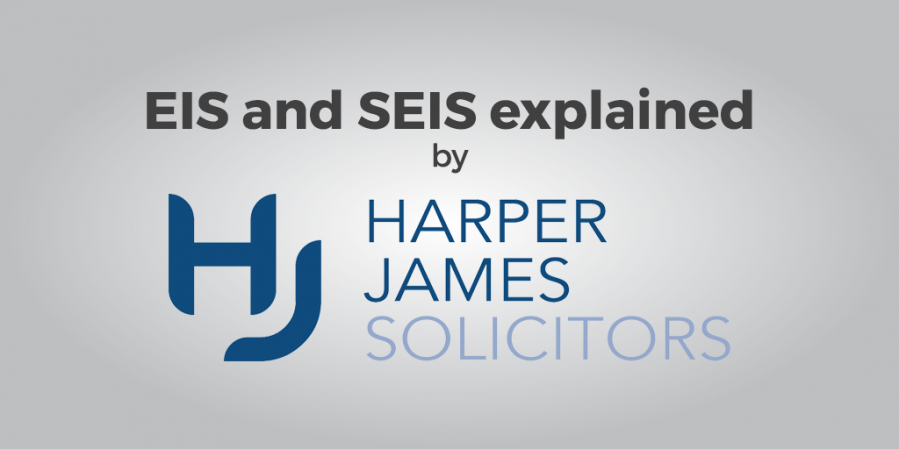Don’t invest unless you’re prepared to lose all the money you invest. NextFin promotes high - risk investments and you are unlikely to be protected if something goes wrong.
Take 2 minutes to learn more.

As legal adviser to a number of investment funds and small to medium-sized businesses, we are often asked at Harper James Solicitors which UK government schemes offer the most tax-effective ways to provide capital to seed, start-up and early-stage businesses.
While the rules governing these schemes aren’t particularly complex, investors and companies looking for funding need to make sure they understand how they work so they don’t fall foul of the rules. Failing to provide the right legal framework may mean that anticipated tax savings aren’t realised, either because the target isn’t eligible at the outset or it becomes ineligible over time due to structural changes.
In this article, we take a look at the EIS and SEIS schemes, what reliefs are available, how to apply for EIS or SEIS investment, and what other considerations companies and investors need to think about when taking advantage of the schemes.
The EIS and SEIS schemes are UK government initiatives designed to stimulate investment in new companies. They provide income and Capital Gains Tax (CGT) relief to private investors when they fund start-up and early-stage companies, provided these companies are unlisted.
Eligible investments are also exempt from inheritance tax.
One major incentive of the schemes is that the net effect of making an EIS or SEIS investment is that funders can reduce their at-risk capital when making an eligible investment to less than 40% of the amount invested.
Here are some recent figures from HMRC showing amounts invested under the schemes, as well as an analysis of the most popular sectors for EIS and SEIS investment:
Source: HMRC
While investing in major companies can provide great returns over time, if you invest capital in small and medium-sized companies, the chance of making larger gains is improved as these companies grow more quickly. Of course, the downside is that investment in these fledgling companies is more risky.
In terms of potential tax savings and incentives, here’s a summary of the reliefs available under the schemes:
You can see more detail on the reliefs and conditions for obtaining the reliefs available under the EIS and SEIS schemes at the end of this article.
The EIS and SEIS schemes are designed to incentivise investors who fund small and medium-sized businesses in return for shares. In order to prepare themselves to become eligible for EIS investment, a company should draw up a detailed funding schedule that projects the amounts of capital it needs in the short and medium-term.
Its owners also need to understand the qualifying terms of the EIS and SEIS schemes (eligible types of business, business size for example), review its existing capital structure (types and classes of shares issued, any restrictions or preferences), and consider any investment already received under the EIS, SEIS and other venture capital schemes as this can impact the amounts it’s eligible to receive.
Owners should also talk to existing investors to let them know the company will be seeking EIS and SEIS investment, as this may impact them.
Under the EIS, a company can raise up to £5 million per year, and £12 million in total over the its lifetime, including monies received under any similar venture capital schemes like the SEIS. This funding must be received within the first seven years of trading.
Your company will be eligible in principle under the EIS if it has a permanent location in the UK, carries out a ‘qualifying trade’, is not listed (or have plans to become listed), is not owned by a holding company, only has ‘qualifying’ subsidiaries, and has not been set up just to carry out a project or series of projects.
The definition of qualifying trade covers the usual commercial activities, but doesn’t include specialist businesses like coal or steel production, farming, leasing, legal or financial services, property development, hotels and care homes, energy production and financial services (see the table below for more detail).
Your company (and its qualifying subsidiaries) must be relatively small, ie:
If your company is more than seven years old, it’s still possible to raise money via EIS if you’re planning to grow your company in a new direction or geographical market, subject to certain conditions being met.
Qualifying subsidiaries are broadly those that your company, or another subsidiary, controls. If the money that your company raises under the EIS scheme is going to be used by a subsidiary, or its business is mostly property related, then the ownership requirement is 90%.
The final condition to bear in mind is that the funds you raise via the EIS scheme must be used for growth and development, for example to increase revenue, scale your business, increase customers or hire staff. What’s more, the investment should carry a risk to the investor; this means that they stand to lose more capital than they would gain from dividends, interest payments or fees, capital growth and tax relief.
If you plan to reduce the risk to investors, for example, by giving them priority over other shareholders, allowing them to withdraw their funding earlier than usual, or otherwise preferring some investors over others, you may not meet the risk to capital condition.
In order to prepare for EIS funding, it’s crucial to understand these rules, and restructure your business plan and capital structure of your company or group so that you can accommodate the requirements of the scheme.
There are different rules for knowledge-intensive companies that do a lot of research and development or are engaged in innovative activities.
In contrast to the EIS, a company can only receive a maximum of £150,000 through SEIS investments, including any state aid it has received in the past three years. As with the EIS scheme, your company will in principle be eligible to use the scheme if it:
A company looking for SEIS investment must not have gross assets of more than £200,000 when the shares are issued, not be a member of a partnership, and have fewer than 25 employees when the shares are issued. Moreover, if you’ve already received investment under the EIS scheme, you can’t receive funding under SEIS.
If your business is intending a funding round that includes EIS or SEIS investment, you will need legal support at an early stage in your planning. Your lawyers will help you with the necessary due diligence, talk to you about your plans, and review your company’s constitutional documents (its articles of association), any shareholders’ agreements in place, the company structure, and the other aspects of the company’s affairs that may impact on eligibility.
When you issue shares to EIS or SEIS investors, these must be paid in full and in cash when they’re issued. The shares must be ordinary shares that are not redeemable, and carry no preferences or other special rights to your company assets. It is possible to allow limited preferential rights to dividends. As we’ve already seen, you can’t make special arrangements with EIS or SEIS shareholders that have the net effect of minimising the risk inherent in their investment, or that are intended simply as a tax avoidance scheme.
Your articles of association will need to be amended to take account of the new shares to be issued to EIS/SEIS investors, and any existing shareholders’ agreements will also need to be amended.
If you’re planning to attract EIS/SEIS investment, or would like to invest in a company under one of the schemes, the rules of the scheme have to followed for a certain period in order to keep the tax benefits under the scheme.
HMRC will withhold or withdraw tax reliefs if the rules of the schemes aren’t respected for a minimum of three years after the investment.
Under EIS, you need to spend the capital you receive under on either your qualifying trade, preparing for a qualifying trade (that you start within two years of the investment), or on R&D that you expect to lead to activities that would be a qualifying trade. You also need to spend the funds raised within two years, and not use it to buy another business.
If you want to make sure that a share issue qualifies under the EIS or SEIS rules, you can ask HMRC to provide you with advance assurance. To do this, you’ll need to send HMRC detailed information about your company including:
For investors looking to buy shares in a company and who’d like to take advantage of the EIS/SEIS schemes, we would recommend contacting us to discuss your options. We would advise you carry out a full due diligence process on the target company before you make a firm commitment, and that includes asking about any previous funding rounds and existing investors.
The first step for investors and companies looking at the EIS or SEIS schemes is to begin gathering the documents and data that HMRC will need, either to obtain advance assurance or to ensure that any shares issued that you want to qualify under the schemes are, in fact, eligible. Harper James can help you review eligibility requirements, conduct due diligence, liaise with third parties including HMRC, and make the required amendments to your constitutional documents.
|
|
EIS |
SEIS |
|
Shareholding duration |
Must hold shares for at least three years.
|
Must hold shares for at least three years. |
|
Income tax relief |
Maximum income tax relief of 30% up to a maximum per investor per year of £1 million (or up to £2 million if £1 million is invested in a knowledge intensive company).
|
Maximum income tax relief of 50% up to maximum per investor per year of £100,000. |
|
Capital Gains Tax |
Exemption for gains on EIS investment if income tax relief is claimed and if shares held for three years.
|
Exemption for gains on SEIS if income tax relief is claimed and if shares held for three years.
|
|
Other reliefs |
Hold-over relief for capital gains.
|
100% relief for assets disposed of in 2012/13, 50% thereafter. Assets must be disposed of in the same year as investment. Capital gains reinvestment relief. |
|
Other tax reliefs/allowable losses |
Relief is given for allowable losses on disposal of the shares against income of the tax year of disposal (or of the previous year) or chargeable gains.
|
As for EIS. |
|
Type of investment
|
Full risk ordinary shares, no preference or redeemable shares.
|
Full risk ordinary shares, no preference or redeemable shares.
|
| Shareholder restrictions | The investor and associates must not hold a stake in company exceeding 30% of ordinary shares, share capital or voting rights and must not otherwise control the company or any subsidiary. The investor must not be an employee, paid director or partner of the company or its subsidiaries. However, so-called business angels qualify. Investors that already hold shares in the company (or subsidiary) will only qualify if those shares were risk finance shares (that is, shares for which an EIS, SEIS, SITR compliance statement was issued or founder shares). | The investor and associates must not hold a stake in company exceeding 30% of ordinary shares, share capital or voting rights and must not otherwise control the company or any subsidiary. The investor must not be an employee of the company but can be a director (whether or not remunerated). Directors are deemed not to be employees for this purpose.
|
|
|
EIS |
SEIS |
|
Assets |
The company must not have gross assets in excess of £15 million before the investment, and £16 million after. |
Gross assets of not more than £200,000 before the investment.
No upper limit post investment.
|
|
Constitution |
The company’s shares must be unquoted, with no arrangements in place for them to become quoted.
Not be controlled by another company during the three-year investment period.
Companies whose shares are listed on Aim are treated as unquoted.
|
As for EIS. |
| Trade activities | The company must carry on trade on a commercial basis with a view to profit. The following activities are not permitted: · Dealing in land, shares, commodities, futures, securities or other financial instruments· Banking, insurance, money-lending, debt factoring, hire-purchase financing or other financial activities· Dealing in goods, other than ordinary retail or wholesale distribution· Letting or leasing assets on hire, except for some ship chartering activities· Receiving royalties or licence fees unless these result from intellectual property created by the company itself· Legal and accountancy services· Property development· Farming or market gardening· Holding, managing or occupying woodlands, forestry activities or timber production· Ship building· Coal production· Steel production· Operating or managing hotels· Operating or managing nursing homes or residential care homes· Energy generation activities (for shares issued on or after 6 April 2016; before that date certain energy generation activities were permitted)· Providing services to a person whose own trade consists, to a substantial extent, of any of the above excluded activities, where the person controlling that trade also controls the investment vehicle
|
As for EIS.
|
|
Subsidiaries |
Control all of its subsidiaries at all times from incorporation until the end of the three-year investment period.
|
As for EIS. |
|
Location |
UK resident company or overseas company with a UK permanent trading establishment.
|
As for EIS. |
|
Financials |
Not in financial difficulty.
|
Not in financial difficulty. |
|
Headcount |
Fewer than 250 employees (FTE) (or 500 for a knowledge intensive company).
|
Fewer than 25 employees. |
|
Fundraising limits |
Can’t raise more than £5 million in total over twelve-month period under the EIS, SEIS and other venture capital schemes.
Lifetime limit of £12 million, or £20 million for knowledge intensive companies.
|
Can’t raise more than £150,000 in a three-year period. |
|
Restrictions relating to prior funding arrangements
|
|
No EIS or Venture Capital Trust investments previously. |
|
Age of company |
EIS investments must not be made in a company which made its first ‘commercial sale’ more than seven years before the date the investment is made (or 10 years for a knowledge intensive company). |
As for EIS.
|
Tagged: Investment EIS SEIS Tax Investors

Alternative Finance: The Four Types Of Crowdfunding

What is Business Interruption Insurance?

The pros and cons to alternative investment in to private companies via debt or equity

What Is The Term Funding Scheme, And Why Is It So Important To Extend It To P2P Lenders?

Need Recognition? Here Is A List of Competitions And Awards
Alternative Finance: The Four Types Of Crowdfunding
The pros and cons to alternative investment in to private companies via debt or equity
What is Business Interruption Insurance?
Should I Invest in P2P?
Self-Employed to Benefit From Second Stage of Support Scheme
How To Start A Business Post-Covid-19
Business Banking Resolution Service To Open In November
Over 1.2m Businesses Have Benefited From Coronavirus Lending Schemes
What is The Start Up Loan Scheme?
Figures Show 730,000 Job Losses Since Start of Lockdown


As seen in:




